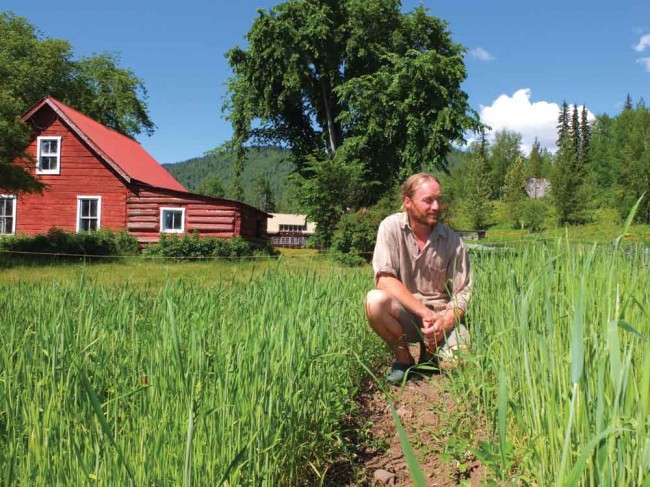
Photo Credit: Alicia Bridges
Crop studies: Learning more about the food we grow
In the 1940s and ’50s, federally funded experimental farms in Smithers and Prince George were part of a network across Canada established to trial new crops and develop the nation’s agricultural prowess.
Staffed by agrologists and other researchers, the farms were a place where producers could seek information about the failures and successes of certain crops to inform their own growing and experimentation.
They had test plots that were open for viewing and their results were shared in newsletters sent to farmers across northern BC.
However, by the mid-1970s, both experimental farms had closed due to reduced funding and no modern equivalent currently exists in northern BC. Today, although some trials still occur on an ad hoc basis, experimentation largely falls in the hands of the farmers themselves.
Old is new
For reasons including local food sustainability, adapting to climate change, economic growth and plain curiosity, forward-thinking northern producers are running their own trials of non-traditional crops and new varieties.
Kispiox Valley farmer Jonathan Knight is not only experimenting with new crops, but also revisiting old ones.
At his organic farm and market garden on a stunning pocket of land between mountain ranges, Knight is growing older, purer types of grains known as heirloom or heritage varieties.
A trained baker, he started using heritage grains at the True Grain Bread bakery he owned on Vancouver Island until 2008, before he started WoodGrain Farm in the Kispiox Valley.
“The theory is that a lot of the problems people have with modern wheats is (because) of the high adulteration that has happened to grain, so that’s one reason to try the older varieties,” he says.
“Another is just that I believe it’s very important to keep old varieties around and not end up with just one or two highly regulated, patented varieties of all these foods that are essential to our continued existence.”
This year, he grew five acres of Red Fife wheat, Canada’s oldest successful variety, and trialled a further 40 heirloom grain varieties. Knight uses a stone mill he built to grind rye and Red Fife flour, which he sells with his vegetables at farmers’ markets in Smithers and New Hazelton.
He says spring-planted heritage wheats like Red Fife are better for making bread, but more challenging to grow in the Kispiox climate. Nevertheless, he believes it is important to rediscover them.
“One day it might not be so practical to bring all of these commodity crops from as far away as we do now,” he says.
Knight says climate change is another reason to retrial crops that might have failed in the past. This year, he is growing cantaloupe and corn, both of which are not traditionally grown in the area.
Curiously cultivating
In a patchwork of plots behind his house on a property outside Telkwa, Curt Gesch also runs small-scale experiments with vegetables and grains.
This year, he trialled five varieties of fava beans and an Amplissimo pea, which can be used to make hummus but is more suited to a northern climate than chickpeas. He shares the results of his small-scale trials in Just Farmers, a monthly agriculture newsletter that he emails to a network of peers.
Gesch says he is driven by sheer curiosity.
“I do lots of things because I’m curious,” he says. “I think that in general people have an inertia and they tend to not question their basic assumptions. They might need somebody else to help them along.”
He records his results for future reference and shares the knowledge with others: “If it’s given in a good format, if it’s in an accessible way, people will read it,” he says. He hopes producers farming on a larger scale will use his results to help increase profits.
“I would like other people who work very hard at what they are doing to get a decent reward for their labour instead of just scraping by,” he says.
Although institution-run crop testing across the region has declined significantly since the days of the experimental farms, trials still occur as funding is made available.
In 2012, University of Northern British Columbia graduate student Serena Black ran a greenhouse trial to test how more commercial, hybrid forms of barley responded to stress compared with heritage barleys.
Prompted by interest from producers, the trial indicated that hybrid varieties had a largely uniform response to stress, while the heritage breeds were less predictable. But the project provided more than just scientific insight.
In consultations with producers after the trial, Black says the strongest message was that, in order to conduct crop trials that asked the right questions, the university should dedicate more time to consulting with farmers. It opened the doors to a larger project, which could bolster crop research and maximize the region’s potential in the long-term.
Working with UNBC associate professor Scott Green, Black has spent the past two summers consulting with farmers throughout the central interior. Their goal is to establish strong relationships with farmers and to work with them to ensure the university’s crop trials tackle the most relevant and important questions.
“The more producers we talked to the more they started referencing the old experimental farms,” she says. “They said, ‘You really need to go back to those if this is what you are looking at because there is so much information that has already been done and collected and researched.’”
Black adds that she doesn’t want to just get the information she needs and then move on: “I think this really needs to have longevity,” she says. “I don’t want to just waste farmers’ time.”
She says small-scale experimentation like what Gesch and Knight are doing plays a big part in helping the local industry progress, but there should be more support for farmers who wish to experiment.
“I think we are vastly under our agricultural capacity and potential and that is not because of the farmers,” she says. “In order to see this potential and show people how many opportunities there are out there, there is a huge need to start giving these producers more support and research is just one component of that.
“Everybody has a way to step up and that’s just going to your local market, to your local farmer, buying direct off the farm.”
Long-term sustainability
Even if a return to the experimental farm model is unrealistic in the current economic climate, Scott Green says the UNBC project could start to develop a knowledge base that is accessible and sustainable for the long term.
“If we’re able to get different seed varieties we could do field tests in the Bulkley Valley on different types of soils, different years, wet years, dry years—we can start to build a database of seed suitability information that would be very useful to producers in helping them to make those types of decisions,” he says, adding that right now there is limited historical data to help farmers make informed decisions about which crop varieties to grow or trial.
“Right now, one, there is no choice and, two, there is very limited information for them to even have in front of them to make those types of decisions.
“Our goal is really to meet with and speak with as many other producers in Smithers as possible,” he says, “to introduce the idea of strengthening the partnership and beginning to develop a research program that could support the specific challenges, interests, needs that producers in the Bulkley Valley are facing at the moment.”




